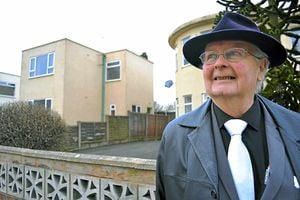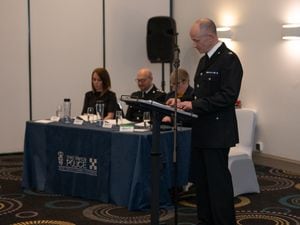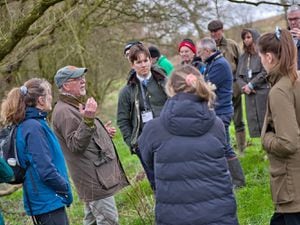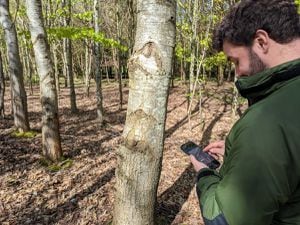Art Deco homes are right up my street
[gallery] His spies are out all over Shropshire. They are hunting for gems of a style which was once at the cutting-edge of fashion, shaping everything from houses and cinemas to cars and aeroplanes.

And you can chance across it in places you might not expect.
Turning into a suburban Telford street, historian and Art Deco lover Phil Fairclough says: "You would never guess that down here is the biggest collection of 1930s Art Deco houses in Telford & Wrekin, and perhaps in Shropshire."
This is Grove Street, St Georges, and part of it is like an Art Deco treasure chest. We count seven houses in the distinctive flat-roofed style, including one that Phil considers to be a particularly fine example, with a semi-circular front.
Why there is such a concentration here is not clear. He says: "I've been told they were managers' houses for the Lilleshall Company, but I'm not sure about that."
He is trying to compile a register of all the surviving examples of Art Deco buildings in Shropshire and is hoping Shropshire Star readers will give him a hand in tracking them down.
"I have a little gang of about five friends out looking. I went to a 1930s house on Shelton Road, Shrewsbury, owned by a real 1930s enthusiast who is very proud of it, and full of 1930s furniture and ornaments inside."
Of course, to identify an Art Deco building, you have to know what you're looking for. Phil says: "It's very difficult to describe, really. Deco is a universal style, which is an important point. It was not just houses. The houses have things in common, usually like flat roofs, and usually with white stucco, and sometimes coloured decoration with a bit of luck, and curving surfaces and symmetrical straight windows."
He says while the movement dates to 1925, the buildings are generally from the 1930s.
"The style degenerated into utility. I think, as the war came along, costs were cut and unnecessary decoration obliterated. It turned into 1940s utility houses, many still with flat roofs and made of concrete blocks." he says.
"Houses were only one aspect of Deco. There were other things like Bakelite radios with go-faster stripes, even Hoovers with go-faster stripes down the side. There was jewellery, clothes, aircraft, ships, tube stations, factories..."
He added: "What I would like to do, because many of them in the area have been changed or even pulled down, is to get a register of those that are left, with photographs.
"But I'm struggling to find them."
He wants anyone who knows of an Art Deco building within the county to give him a ring on 01952 417633.
Phil, who is 72, lives in Shawbirch in Telford, and in his working life was a senior lecturer at Leeds Polytechnic. He has already identified a number of Art Deco works locally.
"I get the feeling that because Shropshire was a more conservative area, people didn't want to experiment with new flat-roofed building styles and preferred much more traditional building types."
Apart from Grove Street, others he has come across include the old Wellington Rural District Council offices in Tan Bank, Wellington, and the stairs at Ercall Wood School in Wellington – which was formerly the town's grammar school.
Cinema buildings were palaces of Art Deco, with the Clifton cinema in Wellington being an example although not, he thinks, among the better ones. He said:?"Some of them were fantastic and in other parts of the country they are classic temples of Art Deco culture."
As for his own Art Deco fascination, that started young.
"I've always been interested. There was a block of 1930s flats at the top of our road and as children we used to sneak past the concierge and play in the lift until we were thrown out. That was in Manchester. And we used to go to Cleveleys, near Blackpool, where there were two Art Deco funfairs."
Today it is overseas where some of the most spectacular Art Deco concentrations can be found.
"South Beach, Miami, is full of classic, coloured, striped super-dupers and Napier, New Zealand, which was destroyed by an earthquake in 1931, was rebuilt and has a lot of 1930s-style buildings."





